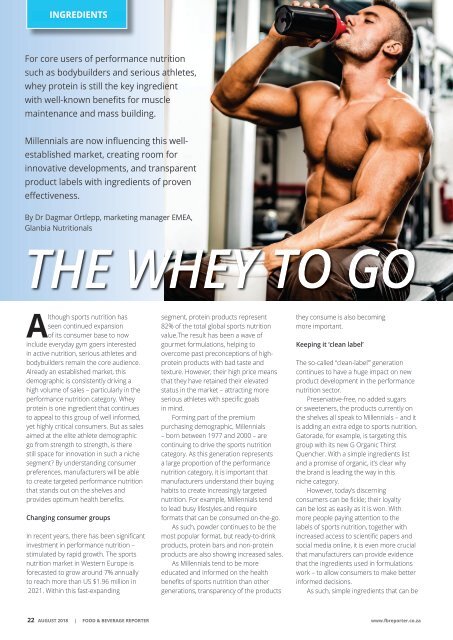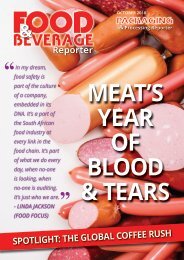Food & Beverage Reporter August 2018
South Africa's leading B2B magazine for the food & beverage sector and its allied industries in processing/packaging etc
South Africa's leading B2B magazine for the food & beverage sector and its allied industries in processing/packaging etc
You also want an ePaper? Increase the reach of your titles
YUMPU automatically turns print PDFs into web optimized ePapers that Google loves.
INGREDIENTS<br />
For core users of performance nutrition<br />
such as bodybuilders and serious athletes,<br />
whey protein is still the key ingredient<br />
with well-known benefits for muscle<br />
maintenance and mass building.<br />
Millennials are now influencing this wellestablished<br />
market, creating room for<br />
innovative developments, and transparent<br />
product labels with ingredients of proven<br />
effectiveness.<br />
By Dr Dagmar Ortlepp, marketing manager EMEA,<br />
Glanbia Nutritionals<br />
THE WHEY TO GO<br />
Although sports nutrition has<br />
seen continued expansion<br />
of its consumer base to now<br />
include everyday gym goers interested<br />
in active nutrition, serious athletes and<br />
bodybuilders remain the core audience.<br />
Already an established market, this<br />
demographic is consistently driving a<br />
high volume of sales – particularly in the<br />
performance nutrition category. Whey<br />
protein is one ingredient that continues<br />
to appeal to this group of well informed,<br />
yet highly critical consumers. But as sales<br />
aimed at the elite athlete demographic<br />
go from strength to strength, is there<br />
still space for innovation in such a niche<br />
segment? By understanding consumer<br />
preferences, manufacturers will be able<br />
to create targeted performance nutrition<br />
that stands out on the shelves and<br />
provides optimum health benefits.<br />
Changing consumer groups<br />
In recent years, there has been significant<br />
investment in performance nutrition –<br />
stimulated by rapid growth. The sports<br />
nutrition market in Western Europe is<br />
forecasted to grow around 7% annually<br />
to reach more than US $1.96 million in<br />
2021. Within this fast-expanding<br />
segment, protein products represent<br />
82% of the total global sports nutrition<br />
value.The result has been a wave of<br />
gourmet formulations, helping to<br />
overcome past preconceptions of highprotein<br />
products with bad taste and<br />
texture. However, their high price means<br />
that they have retained their elevated<br />
status in the market – attracting more<br />
serious athletes with specific goals<br />
in mind.<br />
Forming part of the premium<br />
purchasing demographic, Millennials<br />
– born between 1977 and 2000 – are<br />
continuing to drive the sports nutrition<br />
category. As this generation represents<br />
a large proportion of the performance<br />
nutrition category, it is important that<br />
manufacturers understand their buying<br />
habits to create increasingly targeted<br />
nutrition. For example, Millennials tend<br />
to lead busy lifestyles and require<br />
formats that can be consumed on-the-go.<br />
As such, powder continues to be the<br />
most popular format, but ready-to-drink<br />
products, protein bars and non-protein<br />
products are also showing increased sales.<br />
As Millennials tend to be more<br />
educated and informed on the health<br />
benefits of sports nutrition than other<br />
generations, transparency of the products<br />
they consume is also becoming<br />
more important.<br />
Keeping it ‘clean label’<br />
The so-called “clean-label’” generation<br />
continues to have a huge impact on new<br />
product development in the performance<br />
nutrition sector.<br />
Preservative-free, no added sugars<br />
or sweeteners, the products currently on<br />
the shelves all speak to Millennials – and it<br />
is adding an extra edge to sports nutrition.<br />
Gatorade, for example, is targeting this<br />
group with its new G Organic Thirst<br />
Quencher. With a simple ingredients list<br />
and a promise of organic, it’s clear why<br />
the brand is leading the way in this<br />
niche category.<br />
However, today’s discerning<br />
consumers can be fickle; their loyalty<br />
can be lost as easily as it is won. With<br />
more people paying attention to the<br />
labels of sports nutrition, together with<br />
increased access to scientific papers and<br />
social media online, it is even more crucial<br />
that manufacturers can provide evidence<br />
that the ingredients used in formulations<br />
work – to allow consumers to make better<br />
informed decisions.<br />
As such, simple ingredients that can be<br />
22 AUGUST <strong>2018</strong> | FOOD & BEVERAGE REPORTER www.fbreporter.co.za







